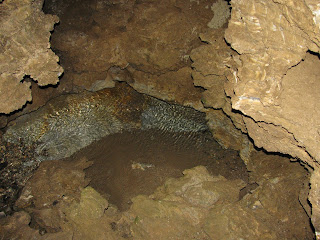While I have some business to attend to in Napa, CA, my final stop for this trip of interest of the blog is at Oregon Caves National Monument in south central Oregon. As usual, I stumbled across this pace when reviewing the map of my trip and since it was only about 45 minutes out of the way, I decided to pay the caves a visit.
The drive up the mountainside is slow going as the road winds and twists its way up a heavily forested canyon, and I take note of the lack of other cars. Finally, arriving at the visitor center, I am a little confused by the signage directing me where to park, but I finally figure it out and walk up to check-in for the Discovery Tour, which I had registered for a few days ago. After speaking with the woman working the desk, I learn that I must speak with a group of rangers outside for "safety training". As it turns out, they are actually screening for potential "white-nose syndrome" carriers. Luckily, I have nothing on me that has been in other caves. I do truly respect and appreciate the work these rangers are doing though. Our native bats are at serious risk due to the spread of this disease and anything we can do to save them, we must!
After meeting with our tour guide, Hope, for some final safety procedures, we enter the cave. It stays at a cool 44 degrees year around with a very high humidity. The entrance is just a few yards from the visitor center and is sealed by a locked grate to prevent rogue explorers from entering and possibly damaging the natural wonder. I've visited a lot of caves over the years, including the largest system known, Mammoth Cave in Kentucky, and I know that all solutional-type caves are formed by the erosion caused by running water, but I've never actually been in a cave with an active stream flowing . . . until now. On the ground below us and underneath a grate, a shallow stream of crystal clear water flows. A blue light installed by the park service gives it a somewhat eerie glow.
Moving further into the cave, we begin to take note of various stalactites, stalagmites, and columns (where the two have joined). Some have been obviously damaged by previous visitors (probably before the cave was under Park Service protection), but most are intact. A number of man-made passage ways have been carved to make the transition between one natural chamber and the next much easier for visitors. Thankfully, the most challenging part of the tour is a section less than 45" tall that one must squat-walk through for ten or so feet.
At the top, I am treated to an amazing sight. I'm not sure what the technical name of the formation is, but I have seen them many times before in this and other solutional caves. The mineral deposits form what looks very similar to a "jellyfish", which is what I have always called them. In this room with a very high ceiling, hundreds of these jellyfish of different sizes at at different levels on the wall have formed. It reminds me of being underwater and seeing a pod of jellyfish float by. This is truly breathtaking.
Finally, we reach the exit of the cave and emerge into the sunlight. It's hard on our eyes at first, but we quickly adjust to life as surface-dwellers. The tour took approximately 90-minutes, but with our excellent guide, Hope, was a terrific experience. I would recommend this cave tour to anyone passing through the area.




No comments:
Post a Comment